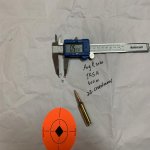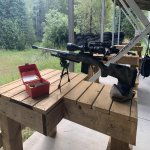Mystic Precision
CGN Ultra frequent flyer
- Location
- Summerland, BC
Well, just don't urinate while standing facing the wind ))
My 16.5" 6.5 783 seems to like the 120 grain ELD-M / 38.8 grain Varget combo (2655 fps average)

Very nice...
Jerry
Well, just don't urinate while standing facing the wind ))
My 16.5" 6.5 783 seems to like the 120 grain ELD-M / 38.8 grain Varget combo (2655 fps average)

What some seem to forget is case capacity allows for alot of options... one of which is throttling down and still getting a ton of performance.
Think V8 vs an overspun 4 banger...
What I love about the 22 CM is the ability to use loads on the starting side of the load profile.... and get performance that rivals some very big toys. And as a byproduct of throttling back, excellent bore life...high teens to low 2's is all I would ever ask from a high performance combo.
with easy and reliable tuning. Sometimes you don't need to crater the primers to have fun....
Jerry
I bought a HB laminate in 6.5 creed on here , just because it was cheap and I was bored , I have buddy's dies here and reloading supplys also .
Tried the same load as buddy 143 hornady with h4350 and it shoots as small as his ctr and any I have . Saying that , I have several that shoot just as well to my limits (500 ish ) 308 with heavier Bullets , 243 , 6mm and 25-06 with faster Bullets 7mm rem mag with the 300win mag for more than paper at longer ranges ( at one time I thought I might shoot game way out there )
I did go out to 800 yds with the mags and the 6.5 but found the wind changes way to much for my skills to try to shoot at critters with confidence
So -- one of many good shooters with no real advantage to me -- I do like the low recoil for shooting more rounds when I feel rich and want to play though . Way cheaper to reload for 500yrd plus rifles , (for me that's just the mags and 6.5 creed )
The rem 783 needed the bbl Chanel relieved and the mag catch needed a bend ( mag was hard to release)
It doesn't feed smooth ( need to pay attention working the action fast or it jams kind of ) backing off and double pump gets it to feed
I think the mags could be better designed.
bolt smooths out with use, the machine marks on the feed ramps need some attention for better feed. we didn't pay remington for pretty machining, just a superior rifle in it's price catagory.
Price range...Savage Axis, Ruger American, TC Encore, Mossberg, in the $450-$600 range the 783 is much better built.Superior to what, exactly?


Jerry, I know you are far too evasive to get pinned down by facts that are contrary to your point... but readers should know that velocity spreads tell the tale, and 300 yards is too close for it to matter much.
A poor 50 FPS velocity spread is only about 0.4 inches at 300 yards, but about 5.4 inches of vertical at 800. For a plate banger that's probably okay, but you know as well as I do that's a fail in F Class.
So its all relative to relative expectations. The velocity variations may be acceptable to some, and short barrel life are less of a cost factor for a guy like yourself who gets barrels at wholesale prices.
My point is that side by side it is very unlikely that a 22 Creed will have velocity spreads as good as typical 6.5 Creed for reasons I explained above. The difference will be harder to spot on paper at close range like 300 yards... but will be in increasing amounts farther out.
Sure your velocities are high, but with that comes recoil when most PRS guys are migrating toward recoil reduction.
No I'm not saying the 22 creed has more recoil than a 6.5 creed. I'm saying it has more recoil as a result of the large powder capacity than a more moderate 22... take your pick.
I know Jerry avoids specifics. If he wanted to post speeds he would have by now. He would rather base his load development on groups size rather than chronograph... he has stated that many times.
I pulled 50 FPS out of my guestimate bag simply as an example for readers to understand the vertical offset value of speed variation at various distances. Jerry's 300 yard group posted above could be achieved with worse that 50 FPS ES... that's the reader take away.
You can divide those verticals in half if the velocity spread is actually 25 FPS... Or by 10 if ES is 5... if Jerry or someone else provides specifics from more than a lucky 3 or 4 shot group preferably groups from different days different temps.
There is a reason why certain cartridge size and bullet combinations are record setting and others are not... if you cant figure out the difference that's on you.
If youre pleased with your 257, good for you... run with it. I dont care. Just never saw one on an F Class track... maybe you should bring that tack driver there some time and spank everyone. Can't wait.
As for the rest of your comment, I dont have the energy to pick nickels with you any further.
Price range...Savage Axis, Ruger American, TC Encore, Mossberg, in the $450-$600 range the 783 is much better built.
I focus on single digit ES, across large sample sizes. That way I don’t even need to look at SD.Genuine question: Why is everyone so hung up on ES? ES is strongly dependent on sample size - the more you shoot, the higher the ES.
Statistically speaking, standard deviation or variance would be much more informative, and what matters in the end is the ability of the gun/load combo to deliver the projectile to a certain area with a certain probability. I.e. if you have 1 outlier in an otherwise good 100-round series, the ES may be bad, but low SD will still tell how the load performs.
Sometimes you don't need to crater the primers to have fun....
Jerry
BLASPHEMY!!!!!
You do recall my 204 loadings with CCI Small Magnum Rifle Primers...or did you forget...









































